12 Corporate Communication Trends Shaping the Way We Work
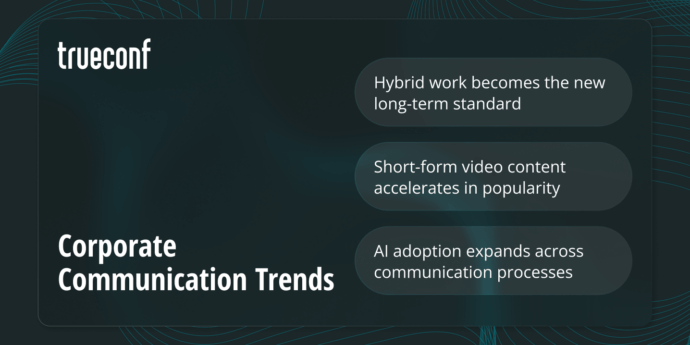
The ways organizations communicate with staff have shifted considerably. Hybrid and distributed work have become widespread, and technology now supports most employee exchanges. In fact, effective communication delivers a quantifiable business outcome: AxiosHQ reports a “direct connection between high employee alignment, engagement, and retention, and effective internal communications”. In this environment, the twelve trends outlined describe how internal communication is transforming. They span emerging work models, channels, technology, and responsibility, all intended at keeping today’s workforce informed and engaged.
Trend #1: Hybrid work becomes the new long-term standard
Hybrid work remains firmly established. Many organizations intend to maintain a blend of in-office and remote arrangements: about 90% of companies anticipate some version of the hybrid model to persist, and 71% of employees favor dividing time between home and office. This transition makes communication increasingly complicated. Teams that previously met in person now require dependable virtual systems so that no one becomes out of sync. For example, companies may host all-hands meetings that include both live audiences and a livestream for remote staff, and they invest in omnichannel platforms so announcements reach everyone regardless of location. Without clear hybrid policies, employees may overlook essential information and feel disconnected. Effective hybrid communication often includes:
- Using multiple channels (email, intranet, chat, video) so on-site and remote workers all get updates.
- Scheduling regular check-ins and virtual town halls where leaders address both in-office and remote teams at once.
- Providing equipment or apps (like Slack or workplace mobile apps) so employees can join discussions from home, the office, or on the road.
By treating hybrid as the new normal, companies ensure information moves smoothly no matter where employees sit.
Take your team communication to the next level with TrueConf!
A powerful self-hosted video conferencing solution for up to 1,000 users, available on desktop, mobile, and room systems.
Trend #2: Personalized communication tools and channels gain strategic importance
“One-size-fits-all” is steadily becoming outdated. Today’s employees frequently expect messages that are relevant to their role and delivered through the channels they prefer. A McKinsey survey indicated workers waste roughly 28% of their week simply managing irrelevant emails. In response, communicators are adopting more personalized methods: segmenting audiences by department or interest, and tailoring content for each group. For example, an HR update might be delivered to managers by email while front-line staff receive a shorter SMS or app notification. Tools that enhance personalization are essential, such as platforms with built-in audience tagging or preference controls.
- Segmented channels: Create specialized channels (e.g. Slack groups, newsletters) for different teams or locations.
- Customized content: Use employee profiles (job title, region) to direct the right updates. A targeted newsletter or intranet portal can ensure, say, engineers only see technical policy changes while sales teams see market news.
- Opt-in preferences: Let staff choose how they want to receive news (email, app, SMS, bulletin). Enabling employees to set their own preferences increases engagement and prevents overload.
By focusing on relevance and choice, organizations ensure important information reaches the right people rather than everyone indiscriminately
Trend #3: Mobile-first communication models continue rapid expansion
Nearly all employees regularly carry smartphones, and many access company information while traveling. In fact, a majority of internet users now browse “solely via mobile devices,” so corporate messaging must remain mobile-friendly. Many firms are developing dedicated mobile apps or using mobile-optimized platforms (e.g. TrueConf, workplace apps) to support deskless or traveling workers. The goal is providing real-time updates: a project manager might send a quick alert or poll through the company mobile app, and a frontline worker receives it instantly. As one industry overview highlights, a mobile-first approach “guarantees individual employees immediate access to relevant information regardless of their location”.
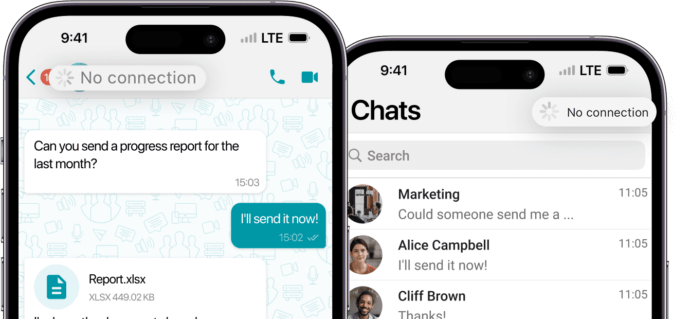
Practical examples feature push-notifications for urgent updates (e.g. safety alerts), on-the-fly surveys through SMS, or mobile-friendly internal social networks. Companies often adjust their content format for mobile: short announcements, image-rich posts, or one-click actions so people can respond while moving or between tasks. In fields like manufacturing or retail, where many employees are not at a desk, a mobile app becomes the primary channel. Prioritizing mobile devices makes communication quicker and more inclusive, especially for employees who work in the field or operate across multiple sites.
Trend #4: Video emerges as the dominant format for virtual interaction
Video is now central to internal comms. While face-to-face meetings are reduced in hybrid settings, companies increasingly use video for everything from CEO updates to training. The pandemic accelerated adoption: many organizations shifted to webinars, live streams, and video
For example, a CEO might record a brief video summarizing quarterly results, or HR may produce a quick clip introducing a new colleague. Video calls (Zoom, TrueConf) have replaced many email exchanges or memo notices. Some companies use asynchronous video: a leader films a message that employees can watch anytime, ensuring even night-shift or remote teams receive it. With 89% of people stating they want more video content from organizations, this trend shows no indication of slowing.
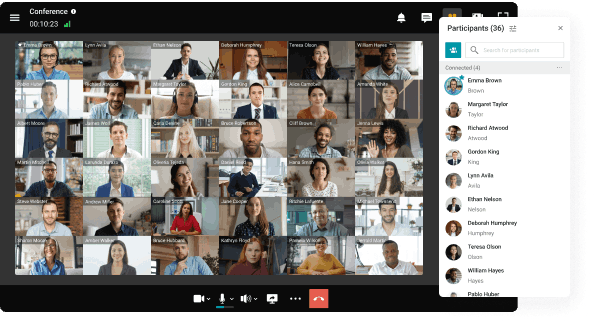
Trend #5: Short-form video content accelerates in popularity
Communications are becoming shorter and sharper. Inspired by social media, businesses are producing bite-sized videos (often under 1 minute) for quick updates and learning. According to HubSpot research, 89% of consumers request more video content, and 75% of video views occur on mobile devices. Internally, this translates to micro-videos for training tips, policy highlights, or event recaps. For example, a safety officer might circulate a 30-second clip demonstrating proper equipment usage. Short videos function well on company chat feeds or on digital signage boards – they capture attention without requiring a big time commitment.
These short clips are ideal for today’s fast-paced environment. They can be shared on an intranet or social feed, ensuring key points remain memorable (people tend to watch short videos to completion). As a practical idea, some companies have launched internal TikTok-style channels: weekly snippets featuring employees or brief interviews. Overall, this trend leverages the proven engagement of video while respecting employees’ busy schedules.
Trend #6: Increasing focus on internal communications ROI and measurable impact
Internal comms are facing more scrutiny. Leaders want to know that communication efforts generate results – whether that’s higher engagement, better retention, or clearer alignment. Nearly half of internal communication teams now list “measuring effectiveness” of comms as a top objective. Companies are tracking KPIs like email open rates, intranet clicks, and survey scores, but they also aim to quantify real organizational impact.
For instance, firms may connect communication projects to outcomes: a successful campaign might be associated with improved employee survey scores or reduced error rates. Survey data from AxiosHQ shows that organizations increasing their comms investment often see better business results – e.g. 63% of them report increased new business revenue, versus 37% of companies that kept budgets stable. This demonstrates a return on communication activities.
To support this trend, many tools now include analytics dashboards. Internal teams use these to gather data (reach, engagement) and calculate ROI. Alongside hard metrics, qualitative feedback is valued – stories of how a clear executive video or timely memo supported a team. In practice, a comms leader might present to executives: “Our recent product announcement email had a 90% open rate and led to 20% fewer support tickets, showing the message was understood.” By highlighting tangible gains (like time saved or policy compliance), communicators make their value evident.
Trend #7: On-demand learning and virtual training experience sustained growth
Employee training has moved virtual and 24/7. Companies continue to build out on-demand learning platforms so staff can access courses anytime. These might include video tutorials, e-learning modules, and resource libraries that employees use at their own pace. The trend is partly driven by skill shortages: organizations need to upskill people rapidly. LinkedIn notes that AI and analytics now enable “dynamic, on-demand, and personalized learning technology”. For example, a company might host a series of micro-courses on a mobile app, allowing employees to learn a new software tool during short breaks. As online learning becomes a continuous expectation for many working professionals, some even choose to pay someone to do my online class when juggling demanding workloads and upskilling commitments.
This growth covers not only technical training but soft skills and leadership development. Webinars, interactive workshops, and even VR simulations are expanding – often recorded or repeatable so remote workers in different time zones can participate. The use of chatbots or AI tutors is also emerging, guiding employees through material. Overall, this trend means learning is integrated into the workday, not merely one-off classroom sessions. Employees expect to pull up a quick tutorial on demand – whether that’s for sales techniques, compliance updates, or new product features – at exactly the moment they need it.
Trend #8: HR initiatives prioritize communication-centric skill development
Human skills like clear communication are receiving special attention. HR departments are increasingly viewing communication as a trainable skill essential for career success. Leadership programs now frequently include modules on storytelling, active listening, and giving feedback. In fact, HR experts emphasize that communication skills are among the top “human skills” that artificial intelligence can’t replace. Training workshops teach managers how to host engaging team meetings, write concise updates, or use collaboration tools effectively.
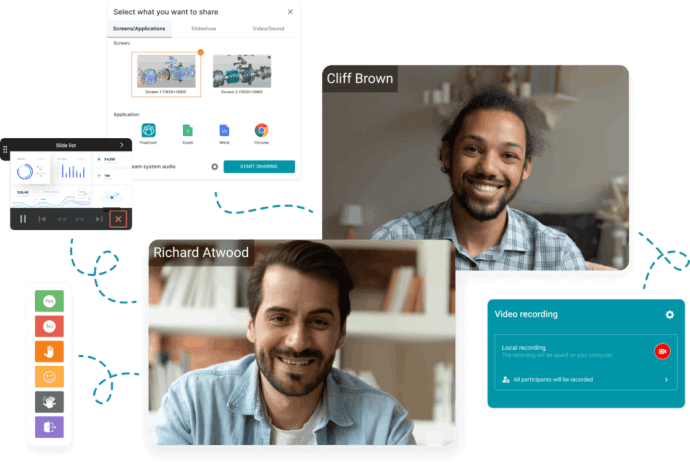
For example, a company might offer a course called “Techniques for Effective Remote Communication,” covering topics like virtual meeting etiquette and inclusive language. Senior leaders are encouraged to refine their presentation style and transparency when speaking to teams. Role-playing exercises may simulate difficult conversations or crisis communications. The goal is to make every employee – from intern to executive – a stronger communicator. By doing so, HR helps create a culture where messages are shared clearly and staff feel heard, which ultimately supports all the other communication trends.
Trend #9: Automation becomes a core component of communication workflows
Routine communication tasks are becoming automated. Tools now manage everything from message scheduling to distribution without manual effort. For example, an HR system can automatically email the next policy change on a set date, or a chatbot can answer common HR queries (like “when is open enrollment?”) 24/7. Even the content creation process is partially automated: as AxiosHQ notes, AI can suggest campaign concepts or generate draft newsletters to save time.
Typical automation use cases include:
- Workflow triggers: Set up triggers so that when one event happens (e.g. a new hire joins), several communications follow (welcome email, training links, team intro).
- Auto-translation: For global firms, messages can be automatically translated into local languages.
- Chatbots and FAQs: Common questions are handled by bots, freeing HR staff from repeat emails.
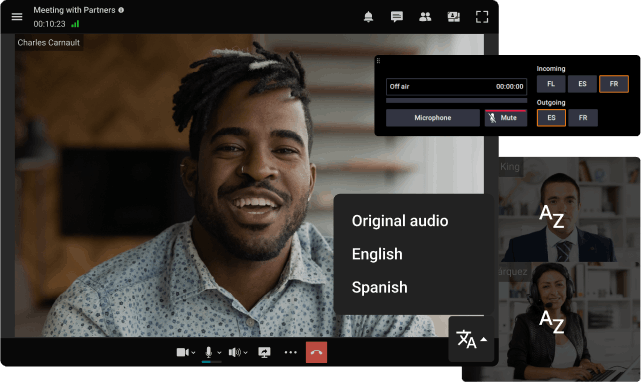
Behind the scenes, systems continually learn from user behavior: they may flag critical alerts (like safety notices) to everyone’s mobile app, or reorganize content feeds for relevance. According to communication analysts, AI now “identifies data patterns to generate self-optimizing workflows”. In practice, this brings fewer manual steps for communicators and quicker delivery of messages. By automating the routine parts of communication, teams can concentrate on strategy and creativity.
Trend #10: C-level leaders show greater engagement in internal communication strategy
Top executives are taking a hands-on role in employee communications. CEOs and other C-suite leaders are more present – they often host webinars, write internal blog posts, or appear in videos to share strategy and culture. DeskAlerts reports that by 2025 “employees expect executive leadership to be visible, authentic, and personally engaging”. Instead of distant memos, many executives now record short phone videos or conduct live Q&A sessions. For example, one government agency introduced a biweekly five-minute video from the department head, who discussed successes and answered employee questions via an internal social feed.
Leaders understand that their active communication builds trust and alignment. Internal surveys show that informal updates (e.g. unscripted video messages) resonate far better than scripted emails. Modern executives often respond directly to employee comments on company intranets or even participate in peer discussion channels. This trend of visible leadership means communication strategy is no longer left entirely to a corporate comms team – C-level buy-in ensures that the tone, frequency, and sincerity of messages align with organizational priorities.
Trend #11: AI adoption expands across communication processes
Artificial intelligence is weaving its influence into every stage of communication. While still emerging, many organizations are piloting AI tools for writing, editing, and decision-making. For example, content creation is being accelerated: teams use generative AI to draft newsletters or summarize reports in seconds. Analytics are improved too – AI can analyze open-ended survey feedback and surface sentiment patterns. As one industry summary notes, AI can “automate repetitive tasks, personalize messaging, and provide real-time data insights,” increasing engagement and reducing workload.
In practical terms, AI is used for:
- Personalizing content: Algorithms select which topics or images resonate most with each team.
- Scheduling: Smart systems decide the best time to send a message for maximum visibility.
- Summarizing: Lengthy emails or meeting notes can be auto-condensed so employees quickly grasp the highlights.
Gartner predicts that by 2025, 30% of marketing messages will incorporate generative AI – and internal comms will likely follow a similar direction. Early adopters are already experimenting: chatbots answer internal questions with natural language, and AI-driven news digests deliver a tailored newsletter based on each employee’s role and preferences. Overall, AI is viewed as a tool to make communication more efficient and relevant.
Trend #12: Internal marketing evolves into a structured, strategic discipline
Finally, organizations are treating internal marketing as a structured practice. This means promoting company values, goals, and culture to employees just as consistently as brands market to customers. AxiosHQ advises that internal communicators “must approach internal communications like marketers—being audience-first, working to make [employees] your brand’s greatest champions”. In other words, employees are considered an audience segment to be engaged.
Companies apply marketing tactics internally: they design campaigns around big announcements, use storytelling and branding in staff newsletters, and even gather “feedback focus groups” to refine messages. For example, an internal campaign might highlight a new sustainability initiative through videos, posters, and employee testimonials, mirroring an external product launch. The results speak for themselves: when executed well, internal marketing strengthens alignment and loyalty. AxiosHQ notes outcomes like better alignment, increased engagement, strong brand advocacy, and an improved employer brand when companies invest in this discipline.
In short, internal marketing turns employees into informed supporters for the company. By strategically packaging internal news with the same care as customer ads, firms ensure that staff understand and champion organizational goals from within.
Conclusion
Corporate communication is rapidly transforming. The shift to hybrid work, mobile and video platforms, data-driven strategies, and new technologies like AI is reshaping how companies keep employees updated. Organizations that adapt to these trends – by empowering leaders to communicate authentically, measuring impact, and personalizing messages – can achieve stronger alignment and engagement. In the end, clear and targeted internal communication remains fundamental to business success.
About the Author
Olga Afonina is a technology writer and industry expert specializing in video conferencing solutions and collaboration software. At TrueConf, she focuses on exploring the latest trends in collaboration technologies and providing businesses with practical insights into effective workplace communication. Drawing on her background in content development and industry research, Olga writes articles and reviews that help readers better understand the benefits of enterprise-grade communication.





Follow us on social networks